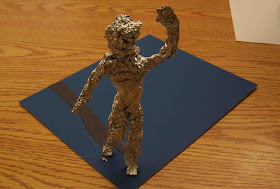 |
| Peace, Love and ART! (Although this artist is frustrated!) |
I showed the children some of Haring's work and they had lots to say about the colors, style and message of the images. I then gave each of them a little articulated paper figure that was cut from card stock that they could use in case they needed help drawing the figures. I got the little figure here, on Christy Hale's website. I told the children that they didn't HAVE to use the figure, it was there if they needed help. I encouraged them to complete the sentence "Peace, Love, and..." We brainstormed a bit on how we could finish that sentence and they came up with some great ideas such as:
- Peace, Love, and Minecraft (of course!)
- Peace, Love, and Cheeseburgers
- Peace, Love, and Art
So, I set them loose. I had stacks of different colors of construction paper available for them to trace the figures onto and then cut out. After they had cut their figures out, they glued them onto a background paper and then traced around them with Sharpie. For the backgrounds, I had long strips of paper or squares they could use, depending on their composition. I encouraged them to add motion and voice lines, etc. with the Sharpie.
I kept this project VERY open-ended because I wanted to see what he students would do. I think I would maybe stress next time that the viewer would need to be able to SEE (ie. figure out) how they are completing the sentence "Peace, Love, and..." that might help them with the imagery a bit. I'll have another opportunity to try the project out with my homeschool kids in a couple of weeks so we'll see how they interpret the lesson.
 |
| Peace, Love and Dancing! |
When the children were done their projects, I had black paper and chalk for them to create graffiti like Haring did in the subways in NYC. I wish I had had some black paper on a roll and I could have had them work really large, but this worked (and they could take their graffiti home with them afterwards!).
Other Keith Haring Lessons to check out:
- Again, this is Christy Hale's Lesson that was published in the Jan/Feb 2006 issue of "Instructor." This link has the instructions for her project to make a frieze as well as a printable template for a little figure that can have either a dog, cat, or mouse head.
- Dali's Moustache has a great lesson where students drawing and painting to create four figures per page with bright-colored backgrounds. Then she has them turn create 3D foam sculptures inspired y their drawings-WOW! I absolutely LOVE her bulletin board display!
- Sarah Ellis Traci has a great Haring lesson where children paint full size Haring figures and make a HUGE mural in the lunch room or down a hallway.
- Once Upon An Art Room uses pastels on black construction paper to create multi-colored gradient backgrounds (great negative space lesson!).
Stop by the above links, tell them Mrs. P sent you and give them some LOVE!


























